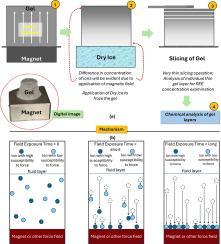稀土元素在明胶介质中的场效应分离
IF 4.8
2区 材料科学
Q1 METALLURGY & METALLURGICAL ENGINEERING
引用次数: 0
摘要
稀土元素(La-Lu + Sc, Y)独特的光学、电子和磁性能导致了各种行业对其需求的显著增加。这一点,再加上萃取、分离和纯化的巨大困难,使得人们对用一种新的方法取代传统的溶剂萃取产生了浓厚的兴趣。为此,一种名为“场效应分离”(FES)的新技术被开发出来,该技术利用离子在强磁场中的磁化率差异将它们彼此分离。虽然已经证明这种方法是可行的,但有必要更充分地了解和优化元素的分离。研究方法是将稀土离子溶液悬浮在坚硬的明胶中,用强磁铁将其分离,冷冻样品以保持分离,并取细片来分析相对于磁铁的不同空间位置以及相对于磁场暴露开始的不同时间的离子浓度。结果表明,磁体表面附近磁敏感的稀土离子具有显著的富集效应,而非磁敏感的稀土离子在磁场作用下相对不集中。此外,在某些易受影响的稀土元素中,在一定的短分离时间尺度上,观察到明显的稀土分层现象。这表明,假设系统可以选择正确的时间和长度尺度,则可以使用FES将ree相互分离。本文章由计算机程序翻译,如有差异,请以英文原文为准。

Field-effect separation of rare earth elements in gelatin-supported media
The unique optical, electronic, and magnetic properties of the Rare Earth Elements (La-Lu + Sc, Y) have led to a significant increase in their demand by a wide variety of industries. This, coupled with the significant difficulty associated with their extraction, separation, and purification, has resulted in a strong interest in replacing the traditional solvent extraction with a new approach. In response, a new technology called “Field-Effect Separation” (FES) has been developed, which utilizes differences in the magnetic susceptibilities of ions in a strong field to separate them from one another. While it has been demonstrated that this approach can work, it is necessary to more fully understand and optimize the separation of elements. The approach taken to study this was to suspend a solution of REE ions in a firm gelatin, separating them using a strong magnet, freezing the sample to preserve separation, and taking fine slices to analyze the concentration of ions at different spatial positions relative to the magnet as well as different times relative to the beginning of the magnetic field exposure. The results show a significant concentration effect for the magnetically susceptible REEs near the magnet's surface, while the non-susceptible ions seem relatively unconcentrated by the magnetic field. Additionally, among the susceptible REEs, at certain, short separation timescales, a significant stratification of REEs was observed. This suggests that the REEs can be separated from one another using FES assuming a correct time and length scale can be selected for the system.
求助全文
通过发布文献求助,成功后即可免费获取论文全文。
去求助
来源期刊

Hydrometallurgy
工程技术-冶金工程
CiteScore
9.50
自引率
6.40%
发文量
144
审稿时长
3.4 months
期刊介绍:
Hydrometallurgy aims to compile studies on novel processes, process design, chemistry, modelling, control, economics and interfaces between unit operations, and to provide a forum for discussions on case histories and operational difficulties.
Topics covered include: leaching of metal values by chemical reagents or bacterial action at ambient or elevated pressures and temperatures; separation of solids from leach liquors; removal of impurities and recovery of metal values by precipitation, ion exchange, solvent extraction, gaseous reduction, cementation, electro-winning and electro-refining; pre-treatment of ores by roasting or chemical treatments such as halogenation or reduction; recycling of reagents and treatment of effluents.
 求助内容:
求助内容: 应助结果提醒方式:
应助结果提醒方式:


